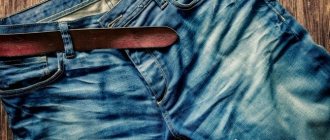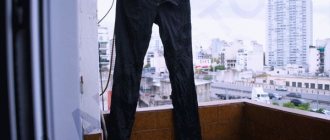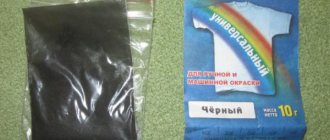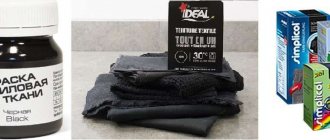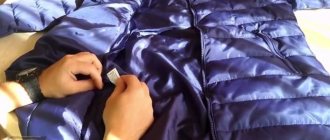How do they dye jeans at the factory?
Dyeing finished melange denim. Denim is made in the usual way, with dyed warp threads and undyed weft threads. Then the finished canvas is painted with the same paint.
Interesting materials:
What is the origin of the Lake Titicaca lacustrine basin? What extension does T2 have? What is the distance from St. Petersburg to Pskov? Which plant grows the fastest? What resolution should the web camera have? What Russian radio? What is the largest apple in the world? What's the strongest beer? What decade is it now? What is the declension of the noun Canalis is m?
The process of dyeing jeans blue
Both water-soluble and water-insoluble substances act as blueing agents.
To dye jeans you need to purchase a soluble dye. It can be indigo carmine, Prussian blue, soluble Parisian blue, blue aniline dyes. Prussian blue dissolves in water only in the presence of oxalic acid. Aniline dyes are usually the most expensive. They have good coloring ability, but can become discolored in the sun. Some aniline dyes turn red after ironing. Among the aniline dyes that are suitable for the production of blueing are methyl blue, methylene blue and wool blue. Ultramarine is an insoluble type of blue. This is a fairly cheap product. You should know that soluble dyes color fabric much more evenly than insoluble dyes.
Make the blue solution according to the instructions on the package. After all, some things turn blue during washing, and some during rinsing. The approximate consumption of bluing is as follows: 0.3 grams per 1 kg of clothing. Stir the powder in cold water and then pour the mixture into warm water. When painting, the following rule works: the richer the shade you want, the less water should be used.
To dye jeans, place them in the solution for at least two hours. After that, just dry it.
Common Mistakes
The most common mistake is using the wrong dye. The composition must be selected taking into account the type of fabric being processed. It is not recommended to dye corduroy trousers. This fabric does not hold color. The second common mistake is that when dyeing they try to get a different color. This approach will not bring the desired result. As mentioned above, when painting in other colors, halftones are obtained.
Before dyeing, it is recommended to degrease the fabric. Third-party particles do not allow the prepared mixture to penetrate deeply into the material, as a result of which light spots will appear on individual parts of the trousers.
Alternative methods
Along with the classics, we also have more exotic coloring methods at our disposal. Sometimes exoticism is dictated by the lack of the dyes you need in the assortment of nearby stores, sometimes by a high creative impulse. If you are looking for original ideas on how to dye jeans blue at home, use one of the suggestions below.
Hair dye
This may surprise you, but yes, some people resort to it. As when using blue, the item is not boiled, but simply soaked for an hour and a half.
Important! The disadvantages here are obvious:
- color is unstable;
- fabric paint is not intended;
- The palette of shades is completely different from that of fabric paints, it’s easy to get confused.
Acrylic paints
This is where the soul of an artist can roam. In fact, acrylic painting is not painting, but painting. Nothing holds back your imagination:
- Take your pants and turn them inside out.
- Select paints and brushes.
- Apply any design.
- Iron it with a sheet of paper on the back.
Ready!
Important! Just keep in mind that the ancient wisdom about the brevity of life and the eternity of art will clearly not apply to your trousers: unfortunately, acrylic drawings have their expiration date and, with repeated washing, fade until the contours are completely lost.
Aerosol
An even simpler and more enjoyable way to dye jeans at home. Here you no longer need a basin, no gauze, no clothespins, no iron. You can make a stencil; you can also get an interesting result if you put fishnet tights or stockings over your trousers and spray a spray can directly on top of them. The only thing simpler than this aerosol is probably a felt-tip pen or a can of paint.
Dyeing with regular fabric dye
At the very beginning, you should determine what type of fabric will be processed. If it is not possible to read the information about this on the label, you need to set fire to a miniature piece cut off from the stock. The smell of burnt paper or burnt hair will indicate that the fabric is natural. When burned, synthetic fibers do not leave an odor or have a specific smell.
The easiest way to change or refresh the color of cotton, wool and other natural materials. Due to their structure, they are easily saturated with the coloring composition, and it is fixed quite firmly. How can you dye the fabric black in this case? Aniline dyes are used for these purposes.
The sachet of the substance is diluted with water according to the instructions. The solution with the fabric immersed in it is brought to a boil. Then you need to add water-salt solution to the main solution (calculation - tablespoon of salt per liter) and continue moderate boiling for at least 40 minutes. To ensure that the paint is absorbed better, do not remove the fabric until the solution has cooled. And the final step will be a thorough rinsing.
About the washing machine itself
After you have dyed your clothes, there is still a problem with the washing machine, because there are paint particles left in it. To get rid of them, run the machine idle.
Important! Immediately after painting, do not wash light-colored items.
Many housewives are worried about their washing machine. Will fabric paint ruin it? What is the best way to dye jeans with fabric dye - in the washing machine or by hand?
- Nothing will happen to the machine, the paint is safe for parts.
- But it is not recommended to dye by hand, since in this case the paint is distributed unevenly across the fabric, and the dishes in which the dyeing is done will be damaged.
Important! If you generally liked the result of the dyeing, but there is still something missing in the design of the product, look through our selection of interesting ideas on how to decorate jeans.
Why is color lost?
The main reason is considered to be frequent washing.
Water and washing powder make the fabric of the product lighter and lighter, washing out the paint. To preserve the color of things at home, it is necessary to use special detergents for black clothes when washing. This helps keep the jeans in their original condition for a while. When purchasing, you should rub your jeans with a cotton pad. If the quality is poor, there will be paint stains.
Shedding is another reason. Some things sometimes stain the water they are in. Although the phenomenon does not mean that the jeans are defective. Natural dyes can also fade. When clothes are first washed, coloring pigments are released. They may also remain on the skin or tissue in contact. In addition, if jeans are worn constantly, including to work, walking, or relaxing, they will lose their original appearance. Also, prolonged exposure to sunlight leads to color fading.
Therefore, it is important to monitor the condition of your clothes so that they last longer.
Useful tips
Before painting, be sure to wash your jeans: they must be absolutely clean. Immerse the jeans in a container with bluing in a straightened state. If they don't fit, fold them in half. In this case, make sure that the water evenly saturates the jeans, as there is a risk that they will dye unevenly. Jeans should not stick out from the pelvis.
Try to dissolve all the blue clumps in the water. If they do not diverge, pour warm water (+30°C) on them. If you want the color of your jeans to be more saturated, leave them in the basin not for two hours, but all night.
If you want the paint to adhere firmly, add a couple of heaped tablespoons of table salt to the blue solution. You can fix the dye by rinsing the jeans in a vinegar solution. This should be done after soaking the jeans in blue. Pour 5 tbsp. vinegar in 10 liters of water. If the fixing power is insufficient, increase the amount of vinegar. Please note that blue fades very quickly. Most likely, after a couple of washes, the painting will need to be repeated.
Water-based acrylic paints are considered the most durable. They can be easily diluted with water. But they are washed off before the first drying. After this it will be difficult to wash the item. Acrylic paints have a very wide range of shades.
What to use?
This is one of the frequently asked questions. There are several options:
- Naturally, more expensive products in powder form are guaranteed to be more effective and the results will last much longer. They are available both in specialized stores and on the Internet, where purchasing them can be cheaper.
- There are often reviews about the use of hair dye. The method saves when there is nothing more effective at hand. True, different manufacturers produce several shades of the same color. The black palette is also quite large. Therefore, the result may be very surprising.
- No less popular are the well-known textile paints. They are much cheaper and require enough time and effort to achieve a good result.
Care after coloring
Dyed clothing must be carefully monitored and cared for. Incorrect washing or drying can change the resulting shade, the item may fade and will have to be thrown away.
After dyeing, you need to properly care for black things
I will share with you some simple tips:
- Dry your clothes where they are not exposed to direct sunlight to prevent them from fading.
- Wash separately from other items for the first 2-3 washes to prevent the new paint from fading.
- Add vinegar during subsequent rinses, it serves as a color fixer.
- When washing, use only powder for colored fabrics. White laundry powder contains bleach.
Vinegar will help the color last much longer.
Black jeans go with any outfit
Where to begin?
Technical progress, having put at our disposal a rich palette of synthetic dyes, makes it possible for every modern housewife to dye jeans blue at home. You can simply return your wardrobe to its former brightness of color, or you can go for a bold experiment, feel like a designer, going against the dull gray-blue-black palette of city everyday life. It's up to you.
In the old days, fabric dyeing was a venerable urban craft. The Street of Dyers in Avignon or the Choir dyehouses in Moroccan Fez, famous since the 11th century, are generally recognized world attractions.
The first two questions about which you need to decide in advance in order to properly dye jeans at home:
- Color and dye.
- Dyeing by washing machine or by hand.
Let's start with the second question, since in general the dyeing procedure in both cases is quite simple and standard, but choosing the right and high-quality dye for jeans is a delicate skill, sometimes acquired with experience.
Important! For improvisations with color spots and uneven shades, hand coloring is perhaps better suited.
Precautionary measures
As with any other dyeing, bluing also requires precautions.
- All painting manipulations should be carried out only with rubber gloves.
- When working with blue and vinegar, you must protect your eyes and mucous membranes. Acrid fumes can cause irritation. Therefore, it is appropriate to wear a medical mask.
- After dyeing an item using bluing, avoid washing this item with other clothes in the future due to the likelihood of shedding.
- All painting work should be carried out in a well-ventilated room.
How to save the result
Dyed denim requires special treatment. How to properly care for these products:
- Wash in warm water, temperature no higher than 40 degrees.
- We recommend manual wet cleaning or machine cleaning on a delicate cycle.
- The best detergent is dark laundry soap. Soap shavings are prepared for machine washing.
- Dyed jeans are washed separately from other items.
- It is advisable to avoid air conditioning.
When analyzing the details, it turns out that dyeing jeans at home is not a difficult process, and the materials are generally cheap. All that is required from the needlewoman is attentiveness, caution when working with hot solutions and a willingness to take risks.
